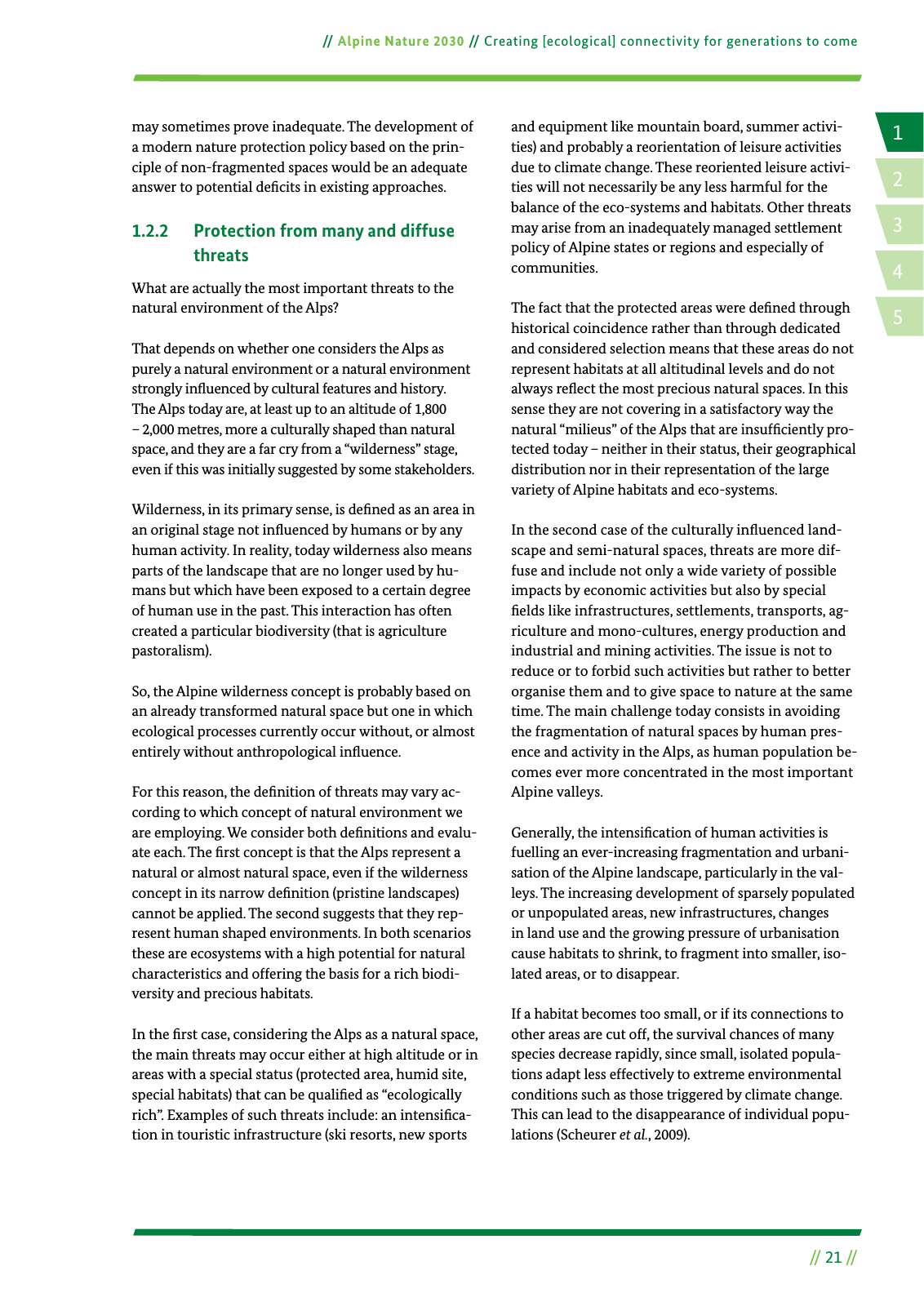14 2 5 3 21 Alpine Nature 2030 Creating ecological connectivity for generations to come may sometimes prove inadequate The development of a modern nature protection policy based on the prin ciple of non fragmented spaces would be an adequate answer to potential de cits in existing approaches 1 2 2 Protection from many and diffuse threats What are actually the most important threats to the natural environment of the Alps That depends on whether one considers the Alps as purely a natural environment or a natural environment strongly in uenced by cultural features and history The Alps today are at least up to an altitude of 1 800 2 000 metres more a culturally shaped than natural space and they are a far cry from a wilderness stage even if this was initially suggested by some stakeholders Wilderness in its primary sense is de ned as an area in an original stage not in uenced by humans or by any human activity In reality today wilderness also means parts of the landscape that are no longer used by hu mans but which have been exposed to a certain degree of human use in the past This interaction has often created a particular biodiversity that is agriculture pastoralism So the Alpine wilderness concept is probably based on an already transformed natural space but one in which ecological processes currently occur without or almost entirely without anthropological in uence For this reason the de nition of threats may vary ac cording to which concept of natural environment we are employing We consider both de nitions and evalu ate each The rst concept is that the Alps represent a natural or almost natural space even if the wilderness concept in its narrow de nition pristine landscapes cannot be applied The second suggests that they rep resent human shaped environments In both scenarios these are ecosystems with a high potential for natural characteristics and offering the basis for a rich biodi versity and precious habitats In the rst case considering the Alps as a natural space the main threats may occur either at high altitude or in areas with a special status protected area humid site special habitats that can be quali ed as ecologically rich Examples of such threats include an intensi ca tion in touristic infrastructure ski resorts new sports and equipment like mountain board summer activi ties and probably a reorientation of leisure activities due to climate change These reoriented leisure activi ties will not necessarily be any less harmful for the balance of the eco systems and habitats Other threats may arise from an inadequately managed settlement policy of Alpine states or regions and especially of communities The fact that the protected areas were de ned through historical coincidence rather than through dedicated and considered selection means that these areas do not represent habitats at all altitudinal levels and do not always re ect the most precious natural spaces In this sense they are not covering in a satisfactory way the natural milieus of the Alps that are insuf ciently pro tected today neither in their status their geographical distribution nor in their representation of the large variety of Alpine habitats and eco systems In the second case of the culturally in uenced land scape and semi natural spaces threats are more dif fuse and include not only a wide variety of possible impacts by economic activities but also by special elds like infrastructures settlements transports ag riculture and mono cultures energy production and industrial and mining activities The issue is not to reduce or to forbid such activities but rather to better organise them and to give space to nature at the same time The main challenge today consists in avoiding the fragmentation of natural spaces by human pres ence and activity in the Alps as human population be comes ever more concentrated in the most important Alpine valleys Generally the intensi cation of human activities is fuelling an ever increasing fragmentation and urbani sation of the Alpine landscape particularly in the val leys The increasing development of sparsely populated or unpopulated areas new infrastructures changes in land use and the growing pressure of urbanisation cause habitats to shrink to fragment into smaller iso lated areas or to disappear If a habitat becomes too small or if its connections to other areas are cut off the survival chances of many species decrease rapidly since small isolated popula tions adapt less effectively to extreme environmental conditions such as those triggered by climate change This can lead to the disappearance of individual popu lations Scheurer et al 2009

Hinweis: Dies ist eine maschinenlesbare No-Flash Ansicht.
Klicken Sie hier um zur Online-Version zu gelangen.
Klicken Sie hier um zur Online-Version zu gelangen.